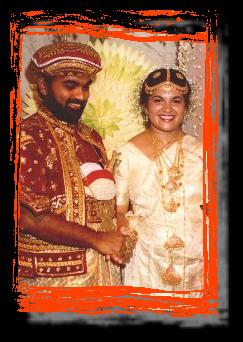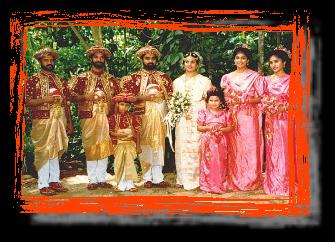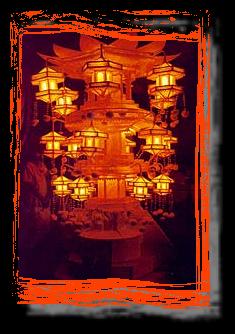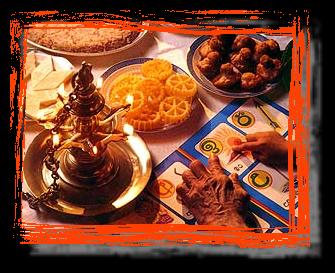|
Sinhalese and
Tamil New Year - Avurudu
Sinhalese and Tamil New Year (avurudu), which is celebrated about the 13th
- 14th of April, is a very
special time in Sri Lanka.
The larders are full since
the harvest has just been
collected, the trees are full of flowers, the homes are freshly painted
and it is time
for festivities.The precise
times when the old year ends,
and the new year begins,
(most times the two does not coincide) are calculated by astronomers, and
is
generally announced by the
peal of temple bells.
Everything during this time
must be performed at
precise times (nakatha),
and in the prescribed way.
The lighting first fire
in the hearth, start of work, first transaction, first application of oil
to hair, first meal, to
name a few. In between these
rituals, the time is
spent playing games, visiting
friends and relatives,
enjoying the many sweets
that are made for the
occasion, and generally
having a great time.
Music and poetry has always been a part of village
life in Sri Lanka, and what
better time to enjoy some
singing and merry making
than the avurudu festival?.
Poetry contests, or contests
between teams of
drummers between adjoining
villages are common
during these celebrations,
These village beauties
playing the "rabana",
a one sided drum, somewhat
like an enormous tambourine,
certainly looks
like a winning team.
|
|


|
Kandyan wedding
A wedding in a village in the hill country
(Kandyan wedding) is an
opportunity not to be
missed by the visitor to
the island.
The chain of events, prior to a wedding is generally started by the marriage
broker, with a visit to the future bride's, or groom's home. The marriage
broker wields a
great amount of power when
a wedding is imminent.
He or she, is a virtual
database for all available brides
and grooms in the area.
Information like how many
siblings in the family,
whom they are married to, what
their worth, age, education,
and any inherited or
acquired diseases are some
of the information
stored in his "little black
book".
The broker,
during his first visit will take stock
of his/her "clients" family
and suggest several possible "matches". The family then has to decide which
of the prospective bride's or groom's homes to visit for a
preliminary "inspection".
All stops are pulled, when it
comes to entertaining, by
the host family for this visi
t by the guests,- after
all first impressions go a long
way. However the guests
rarely get to see the future
bride or the groom during
this first visit. He or she will be presented ""properly" later, during
a subsequent visit.
The broker will arrange
several more visits over a
period of several months
to each other's families and
during one of these visits
the bride or the groom will
make a brief appearance,
perhaps serve a drink. In
most arranged marriages,
like most marriages in the
villages are, one is marrying
into a family, and
thereforethe individual
bride or the groom takes a
lessor role, as long as
they are compatible as
determined by their horoscopes.
This astrological
"match" will be determined
by the local astrologer.
|
During the subsequent visits the families will discuss the amount of "dowry",-
a payment (in cash and/or property)
by the bride's family to
the grooms family, - and the future partners will get to know each other
a little bit better. If everything is agreed to mutual satisfaction, a
wedding day will be selected by the astrologer. The preparations for
the wedding generally starts
several days before, sometimes several weeks, if, for instance, the house
needs to be repainted. Otherwise, men in the village will start decorating
the house, and the road leading to it. Usually, a temporary archway (thorana)
is erected using palm trunks by the side of the road, and decorated with
fresh palm fronds, palm inflorescence, and bunches of coconut and other
fruits.
All the cooking is done by
the women of the village. Their marathon cooking session starts several
days before the wedding day - first sweets and other foods that are non-perishable,
then on the night before the wedding day, all the
foods for wedding feast.
During this time the whole village takes on a carnival atmosphere, with
firecrackers,
continuous loud music, some
heavy drinking by the men, and some attempts at hanky-panky by the young
eligibles.
The day starts with a visit
to the local temple to receive Buddha's blessings. Afterwards, the groom
is dressed in traditional clothing similar to that were worn by the Kandyan
chieftains, complete with the ornamental dagger. The
bride is adorned in all
her finery with gold embroidered sari and heavy gold jewelry.
Then at the prescribed auspicious
time the wedding vows are taken, inside a poruwa, a temporary stand
decorated
with flowers, and palm fronds.
The customs are somewhat similar to the western customs. Wedding rings
are
exchanged by the bride and
groom, and gifts are offered to the elders of the family, and photographs
are taken
for posterity. The local
registrar of marriages, who is always an invited guest, will do the necessary
paperwork.
Until the poruwa
ceremony the bride and groom who were kept separated, now get to sit together
and enjoy the
wedding feast. Soon after
the wedding feast it is time for the bride to accompany her new husband
to his
home and another round of
rituals and celebrations.
|
|
Vesak Lantern
If any single day in the Buddhist calender is of
equal importance to the
Christmas day in Christian
calender, it has to be the
day of Wesak. All over the country, temples, in the villages, and
in the cities,
announce the dawn of Wesak,
with peals of bells, and
drum beats. The devout,
clad in pure white, with no
make-up or jewelry, make
their way to the temple, to
spend the next twenty four
hours in quiet contemplation.
No solid food in taken after
mid-day meal, for this day,
the holiest of days in the
Buddhist calender, one is
there to rid the mind of
impure thoughts, and the body
of impure habits. (Observe
Sil).
While the rest of the
village, gather at the temple
grounds after sunset to participate in lesser religious activities, like
reading of
holy books, or listen to
the saffron clad monk relate
ancient stories from Lord
Buddha's previous lives.
( listen to Bana
).
Simple candle-lit lanterns like these, that seem to fascinate these youngsters,
made with bamboo frames
and covered with colored
transparent paper adorn every house, for Wesak, is a muted celebration
as well. Over two-and-a-half centuries ago in northern India, Gautama
was born, attained Enlightenment,
and passed away, on
the same day of the month,
separated by some 80
years. and Buddhists all
over celebrate the three
events on Wesak day.
|
|
 |
With the growth of commerce, many large businesses
in cities like Colombo saw
the commercial possibilities
of Wesak, similar
to how the businesses in the west embraced Christmas. Sending of Wesak
cards to friends and business associates has become the done thing,
during the month of May.
Shops selling large and
small lanterns, candles,
and various electric lighting
sets, and papers of any
imaginable color abound.
Many of the bigger companies
pay other small
companies to make large
Wesak lanterns like these
in the hope of attracting
prospective customers, and
they do come .... Traffic
in the streets leading to
more popular sites, bad
during normal days becomes impossible during the Wesak Holidays.
This Wesak
lantern, elaborate and several
tiers high, could have
cost the sponsor quite a
large sum of money, but that
would be offset with the
extra sales !!!.
|
|
Kandy
There are ceremonies and rituals associated with
every part of Sri Lankan's
life. From birth, first solid
meal, first lesson, first
job, and "first" anything must be
done at the right, and auspicious
time, dictated by
ancient and somewhat mysterious
legends and lore.
Some of these rituals may
only involve a visit to the
village temple, or a small
offering to the Gods, but the
major ceremonies, specially
that are religious in nature
are, are celebrated to the
full. The Esala Perahara in
Kandy is the biggest of
these events.
|
|
 |
The first day
We in Sri Lanka can, and most certainly do, turn
any opportunity into a celebration.
The first day in school, first day at a new job, "first" of any thing call
for some
form of reveling. A child's
first solid meal, therefore, is a
time for rejoicing. For
that day, for the children, many varieties of sweets, a big pot of "kiri
bath," (rice cooked
in coconut milk), and for
the adults, a veritable feast of
rices, vegetables, meats
and fish are prepared.
Prior to the auspicious time, the sweets, milk
rice, a sheaf of betel leaves,
some coins, gold and
silver, books, a ceremonial
oil lamp, and many other
items used daily by grown-ups
are spread around on a woven mat, with room for the guest of honor in the
center.At the "proper" time
the child is placed in the
center ofthis "slice of
life" and carefully watched for
what attracts him most,
for according to tradition this dictates what he is to become later in
life. If the coins
are touched first, a life
as a trader, or a banker is in
store, the leaves, a farmer,
perhaps, and the book,
definitely a scholar.
This child certainly seems bent on being a scholar,
or is it that a lesson from
a loving "loku attha,"
(great grand father) too
much to pass over?.
|
|
